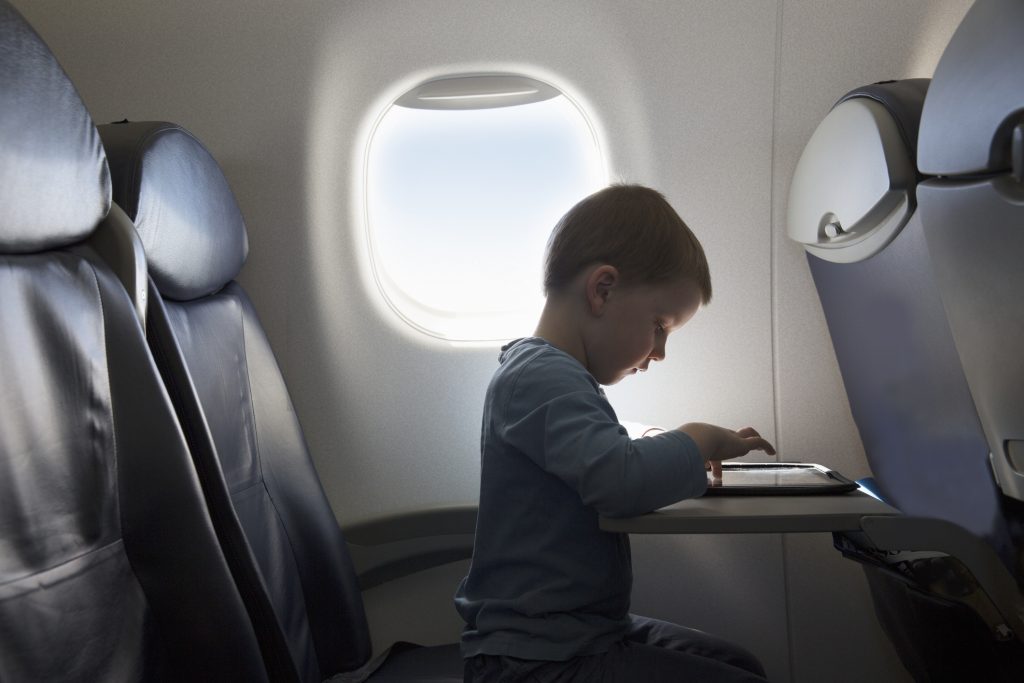Air travel safety tips for children with autism
Signing up for credit cards through partner links earns us a commission. Terms apply to the offers listed on this page. Here’s our full advertising policy: How we make money.
Kids look forward to traveling as an exciting break from their ordinary routines. However, many children with autism spectrum disorder (ASD) may find the change stressful. As if airplane travel isn’t enough of a challenge to both the child and parents, flying in the age of COVID-19 adds another layer of complications. Fortunately, there are ways to prepare ahead of time for ASD travel to make getting from here to there smoother.
It’s all too easy to skip the travel plans and stay home instead, but the effort invested in getting your kid comfortable with flying is well worth it. Travel can literally open up a new world for your child. Managed properly with lots of love, patience and foresight, a flight can provide an important learning opportunity for everyone involved.

The benefits of travel for autistic children
You may be wondering whether it’s worth pushing your child beyond his or her comfort zone for autism-friendly vacations, to visit family or meet with an out-of-town medical specialist. The benefits of travel for your autistic kids could outweigh the challenges:
- Encourages independence: Helping your child navigate an airport can provide practical lessons regarding time-keeping, maps and following steps to reach a goal. Air travel is a valuable lesson and a life skill worth developing.
- New learning experiences: Many autistic kids have a deep curiosity and desire to study and absorb new things. Travel is a great, hands-on learning experience.
- Social exposure: Isolation is a common issue for families with an ASD child. Air travel provides an opportunity for interactions with others. And one positive of traveling during the pandemic is the requirement of social distancing, providing a buffer for kids who may struggle most with this aspect.
- An opportunity for real-world sensory desensitization: For kids with more intense sensory reactions, air travel can be helpful to face stimulations that may feel irritating or negative to “desensitize”.
- Relaxation: All ASD families could use a well-deserved break now and then. Although the change in routine could be a bit difficult to manage at first, having family time to bond away from an everyday schedule could be a great way to recharge.
Although you may still feel hesitant about air travel, remember that the lasting benefits may be well worth the travel preparation and initial stress leading up to a plane ride. The following planning ideas will help you and your ASD kids travel by air happily, comfortably and safely.
How to prepare for air travel with a child with autism
Rebecca Murphy, certified Parent Coach and owner of Real Life Parent Coaching has spent close to 20 years working with children on the spectrum and their families. She recommends, “allocating some time to plan and prepare ahead of the trip.” You can’t predict everything that could happen, but you could have the tools you need ready and available to make the transition from your home to the airplane to your destination as smooth as possible.
Ways to get ready
Try some of these five ideas before you start packing your bags. They’ll help you and your child know what to expect:
1. Choose a destination based on your child
Get your child on board with a trip by choosing a location that will interest them. For some families, a nature trip to the mountains or a beach may be the best option. For others, replacing outdoor time with a visit to a city of museums may be a good choice.
2. Include your child when planning
Your child’s input on travel logistics can be valuable. Include them during certain parts of the planning phase, like asking them to choose two or three items to pack, or whether they’d like a window seat or aisle on the plane. Giving them some control in ways that are easy to fulfill will help them mentally prepare for the trip.
3. Prepare for sensory concerns
Having short, casual discussions on how their sensory issues may be challenged could help you both prepare. For example, discussing how an airplane’s engines could be loud for kids who react negatively to noise helps them learn what to expect. Together, you may come up with a solution, such as buying a special travel headset that minimizes noise — or at least replaces it with more tolerable ones, such as music.
4. Show them videos of what they can expect
Finding videos about travel can help them visualize what they’re about to do. Nicole Thibault is an Autism Ambassador for Mesa, Arizona, the first autism-certified city. She produces and creates a variety of travel videos for ASD kids. Nicole says, “By watching videos before they depart on their trip, the individual with autism can familiarize themselves with the destination and feel more at ease about traveling to someplace new.”
Some good video resources your kids may enjoy include:
- TSA animated series for kids
- This Star Alliance short video on what to expect for safer travel during the pandemic
- Sesame Place Autism Social Stories
- Captain Roger Victor’s airport tour
5. Introduce some of the rules of travel
In the days and weeks before the trip, tell your child about how it’s important on the flight to keep the seatbelt on when asked. Discuss why it’s important to wear a mask at all times during the flight (unless it’s medically exempted). You may even want to practice sitting still for 20 minutes or longer while they do an activity to simulate what’s expected during take-off or landing.
Plan what you can ahead of time
Avoiding guesswork once you’re on the way can help you focus on your child’s needs and reactions instead. The more you plan ahead of time, the freer you are to stay in the moment with your kid.
Call ahead to make arrangements
Let the airline know you’re traveling with a child with ASD. The airline may give you more flexibility, such as allowing you to preboard or assigning someone to help you get to the gate.
Call TSA Cares (1-855-787-2227) 72 hours prior to traveling for help with screening procedures and how to find a Passenger Support Specialist (PSS) at the airport. You can also request an Autism Spectrum Disorder Notification Card for pre-boarding and access to special security lines, or print one from home.
Create a safety plan
Set up a safety plan that covers what to do if you’re separated. Besides helping your child identify what airport staff looks like if they need to ask for help, the following items could come in handy:
- Kid-friendly cell phone
- Medical alert bracelet
- Pin or tag with your cell phone number
- GPS tracker
- Temporary safety tattoo
Pack the essentials on your person
If your child has a certain item such as a favorite stuffed animal or security blanket, don’t check it in. Pack it in a carry-on or backpack that stays with you. Depending on the item, you may want to have a second back-up of the comfort item, in case it’s lost. Delayed or lost bags happen, unfortunately. Make sure you pack a few essentials in your carry on, such as:
- Spare clothes
- Favorite snacks
- Entertainment items
- Toiletries
- Gum or chewy snacks to help the ears equalize during take-off and landing
Take a practice run
If you live near an airport, you may be able to sign your child up for an airport “rehearsal” before the actual day of travel. Wings for Autism arranges airport “test runs” at select airports for kids to practice checking-in, going through security, waiting in line and the airplane boarding process. American Airlines partners with Clearbrook to host mock flights in Chicago twice per year for kids with autism.
Airport tips for children with autism
An airport can be overwhelming for the average traveler. For someone on the autism spectrum, the sights, sounds and crowds can be a major sensory shock. Rest assured, there are ways to ease the transition.
Arrive early
It’s better to have time to spare than have to rush to the gate. Getting to the airport early takes some of the stress out of the whole check-in, security and gate process. Once you get to the boarding area, if you have a longer wait than expected or a delayed flight, consider using your travel credit card’s benefit of airport lounge access. Lounges are typically less busy than the gate area, providing a buffer for your child until it’s time to board.
Have a meal or snack ready
Make sure your child is eating and drinking enough to avoid a blood sugar crash. Be sensible about the types of snacks they’re eating. Avoid sugary snacks that could make your child hyper right before they’re expected to sit for hours.
Address toilet time
Airport and airplane restrooms may be the hardest part of the trip. The automatic flushers and hand dryers are loud and often start-up randomly or continuously. For kids with sensory sensitivities, the noises may be overwhelming.
Many airports have a family restroom which is more private and potentially less noisy (and stressful) to use. Encourage your child to use the airport toilet before boarding since their next chance won’t come until the pilot reaches cruising altitude.
If your kid has to use the plane toilet, calmly and reassuringly let them know what to expect — the small, cramped airplane lavatory with the scary, loud flush may be a lot for your child to handle. If you have a shorter flight of a couple of hours or less, controlling the amount of liquid your child drinks can be helpful in minimizing toilet visits.
Board early
Boarding early gets you on the plane before the crowd and gives you time to set your child up comfortably. Once you get on board, make sure your kid has an activity to engage in that provides some distraction while the rest of the passengers make their way to their seats.
Have activities to pass the time
Your child’s carry-on should include some of his or her favorite things to do and a few new things that could work as distractions if needed. Some ideas include:
- A small puzzle that could fit on a compact tray table
- A new game for their tablet or handheld device
- Play-Doh or clay
- A book to read
- Coloring book and crayons/markers
- Magnetic travel chess or checkers
- Playing cards
Resources
There are resources and programs available to help you prepare for your upcoming trip. They include:
- TSA Cares: Airport assistance through the security screening process
- Autism Speaks: Autism travel articles and guides
- Autism Travel: Autism-certified vacations and recreation activities
- Clearbrook: Programs and resources for people impacted with developmental and intellectual disabilities. Organizes mock flights with American Airlines twice per year.
- Wings for Autism: Organizes airport rehearsal runs
- Madison House Autism: Offers a printable flight book of identifying information for travelers with ASD
Bottom line
The hardest part of travel may be the preparation. There are many details to cover but if you plan in advance, airplane travel doesn’t have to be impossible. There are resources and support services available to help you make it on — and off — the plane as seamlessly as possible. Best of all, surviving the first leg of your journey comes with the best reward: quality time with your child.
Editorial Note: We're the Million Mile Secrets team. And we're proud of our content, opinions and analysis, and of our reader's comments. These haven’t been reviewed, approved or endorsed by any of the airlines, hotels, or credit card issuers which we often write about. And that’s just how we like it! :)


Join the Discussion!